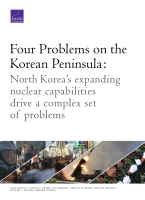PDF file 20.7 MB
 North Korean provocations and threats have created an unstable environment on the Korean Peninsula. North Korea's ongoing development of nuclear weapons and ballistic missiles increases the possibility of their use against regional states, furthering instability across the region and beyond. The United States, its allies, and other theater powers, including China and Russia, must attend to four interconnected threats. Failure to prepare will increase the chance of mistakes and miscalculation and constrain options to reduce the likelihood or gravity of future conflicts.
North Korean provocations and threats have created an unstable environment on the Korean Peninsula. North Korea's ongoing development of nuclear weapons and ballistic missiles increases the possibility of their use against regional states, furthering instability across the region and beyond. The United States, its allies, and other theater powers, including China and Russia, must attend to four interconnected threats. Failure to prepare will increase the chance of mistakes and miscalculation and constrain options to reduce the likelihood or gravity of future conflicts.
Problem 1: North Korea is on a trajectory of nuclear development that has transformed it into a fundamentally different kind of strategic challenge — a state with a significant nuclear arsenal, an increasing range and number of delivery systems, and a nuclear doctrine of early or even preemptive use.
Problem 2: North Korea has medium- and long-range artillery that can hold South Korean population centers hostage to a massive conventional and chemical barrage.
Problem 3: If North Korea employs chemical, biological, or nuclear weapons or conventional artillery against Seoul, up to 25 million South Koreans, 1 million Chinese, and 500,000 other foreign citizens — including 150,000 Americans — might be in immediate danger. This could trigger mass panic and prompt a massive civilian evacuation of Seoul and other population centers.
Problem 4: A regime collapse could occur with little warning and have disastrous implications. Possible consequences include a civil war; a massive humanitarian crisis; and the potential for the theft, proliferation, and use of North Korea's chemical, biological, and nuclear weapons.
No comments:
Post a Comment